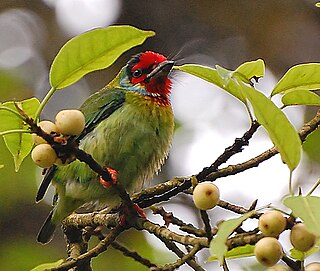
The coppersmith barbet, also called crimson-breasted barbet and coppersmith, is an Asian barbet with crimson forehead and throat, known for its metronomic call that sounds similar to a coppersmith striking metal with a hammer. It is a resident bird in the Indian subcontinent and parts of Southeast Asia. It carves out holes inside a tree to build its nest. It is predominantly frugivorous, but has been observed eating insects, especially winged termites.

The brown-headed barbet is an Asian barbet species native to the Indian subcontinent, where it inhabits tropical and subtropical moist broadleaf forests.

The bearded barbet is an African barbet. Barbets are birds with a worldwide tropical distribution, although New World and Old World barbets are placed in different families. The barbets get their name from the bristles which fringe their heavy bills.

The crimson-fronted barbet, also called Sri Lanka barbet, is an Asian barbet endemic to Sri Lanka where it inhabits tropical moist lowland forests up to 1,300 m (4,300 ft) elevation.

Vieillot's barbet is a small bird in the family Lybiidae. Barbets and toucans are a group of near passerine birds with a world-wide tropical distribution. The barbets get their name from the bristles which fringe their heavy bills. This bird is named after the French ornithologist Louis Pierre Vieillot.

The white-cheeked barbet or small green barbet is a species of Asian barbet found in southern India. It is very similar to the more widespread brown-headed barbet, but this species has a distinctive supercilium and a broad white cheek stripe below the eye and is found in the forest areas of the Western Ghats, parts of the Eastern Ghats and adjoining hills. The brown-headed barbet has an orange eye-ring but the calls are very similar and the two species occur together in some of the drier forests to the east of the Western Ghats. Like all other Asian barbets, they are mainly frugivorous, and use their bills to excavate nest cavities in trees.

The toucan barbet is a barbet native to western Ecuador and Colombia. Along with the prong-billed barbet, it forms the family Semnornithidae, and is closely related to the toucans. It is a medium-sized barbet with a robust yellow bill. It has striking plumage, having a black head with grey throat and nape, red breast and upper belly, yellow lower belly and grey wings and tail.

The Malabar barbet is an Asian barbet native to the Western Ghats in India. It was formerly treated as a race of the crimson-fronted barbet. It overlaps in some places with the range of the coppersmith barbet and has a similar but more rapid call.

The great barbet is an Asian barbet native to the Indian sub-continent and Southeast Asia, where it inhabits forests up to 3,000 m (9,800 ft) altitude. It has been listed as Least Concern on the IUCN Red List since 2004 because of its wide distribution.

The golden-throated barbet is an Asian barbet native to Southeast Asia, where it inhabits foremost forests between 900 and 2,700 m altitude. It is listed as Least Concern on the IUCN Red List because of its wide distribution and stable population.

The black-browed barbet is an Asian barbet native to Peninsular Malaysia and Sumatra, where it inhabits foremost forests between 600 and 2,000 m altitude. It is listed as Least Concern on the IUCN Red List because of its wide distribution and stable population.

The brown barbet is a species of bird in the family Megalaimidae. It is found in Borneo. Its natural habitat is subtropical or tropical moist lowland forests. It is threatened by habitat loss, and has lost approximately half of its connected habitat since 1973.

The white-mantled barbet is a species of bird in the family Capitonidae. It is endemic to Colombia.

The scarlet-banded barbet is a species of bird in the New World barbet family, Capitonidae. It is endemic to Peru.

The lemon-throated barbet is a species of bird in the New World barbet family Capitonidae. It is found in Bolivia, Brazil, Colombia, Ecuador, and Peru.

The versicolored barbet is a very colorful species of bird in the family Capitonidae, the New World barbets. It is found in Bolivia and Peru.

Chaplin's barbet or the Zambian barbet, is a bird species in the family Lybiidae, which was until recently united with the other barbets in the Capitonidae. This bird was named in honor of Sir Francis Drummond Percy Chaplin, a former colonial governor. The species was renamed to emphasize its status as Zambia's only true endemic bird species. It is endemic to South Central Zambia and is restricted to the area between the Upper Kafue River to Kabanga in the Kalomo District. Its natural habitats are moist savanna and arable land. It is threatened by habitat loss. It was formerly classified as a Near Threatened species by the IUCN. But new research has shown it to be rarer than it was believed. Consequently, it is uplisted to Vulnerable status in 2008.

The red-crowned barbet is part of one of the two subfamilies of Megalaimidae birds. it is in the order of woodpeckers (Piciformes) and their relatives. It is distributed in Myanmar, Thailand, Malaysia, Singapore, Indonesia and Brunei. Its natural habitats are subtropical or tropical moist lowland forests and plantations with a breeding distance of 3,180,000 km (1,980,000 mi).

Whyte's barbet is a species of bird in the family Lybiidae. It is found in Malawi, Mozambique, Tanzania, Zambia, and Zimbabwe.

The Usambiro barbet is a species of bird in the African barbet family Lybiidae. It was formerly considered a subspecies of D'Arnaud's barbet, along with Emin's barbet, but was split as a distinct species by the IOC in 2021. It varies from the nominate in having a longer wing, shorter tail, darker bill. The Usambiro barbet was originally described as a subspecies of D'Arnaud's barbet in 1908 by Oscar Rudolph Neumann from a specimen collected in Usambiro in Tanzania. It is now treated as a valid species in its own right.





















